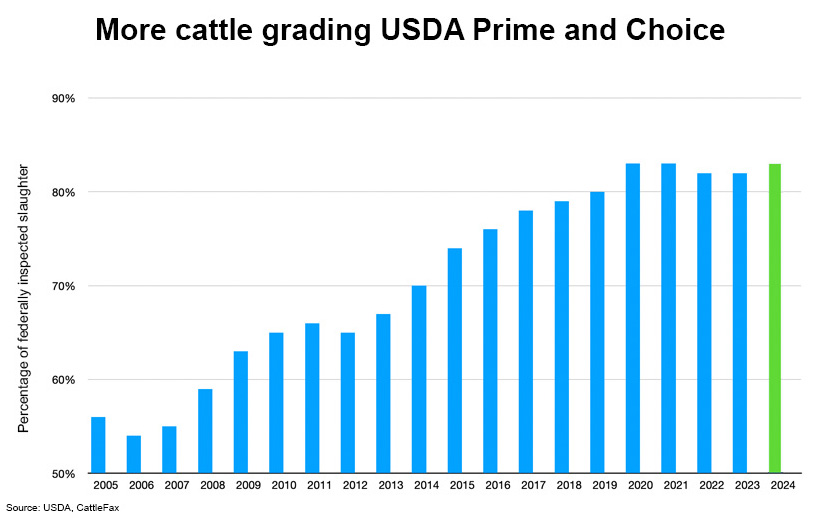The American beef cattle sector has a problem. A good problem, but a problem nonetheless. American cattle are getting better quality grades than they used to.
Investments in better genetics, feed research and animal husbandry have all contributed to broad improvement in the quality of the nation’s beef cattle herd. More than 80% of the nation’s herd graded either choice or prime, the two highest grades available, every year since 2019.
The bulk of that beef is in the choice category; prime beef has consistently hovered around 10% in recent years. According to CattleFax, a beef industry economics firm, the percentage of the nation’s federally inspected beef cattle grading either prime or in the upper two-thirds of the choice category was about 32.6% in 2023, an increase of 95% since 2005.
With the majority of the product being labeled in the industry’s higher classes, two industry economists told Agri-Pulse conversations are taking place within the sector about the merits of modifying the beef grading system, potentially by adding a grade above prime.
Asked at what point the industry should begin exploring the changes, Terrain Chief Research and Analytics Officer Don Close said, “I think we’re there. I do, and I’ve been in some conversations on that.” CattleFax Vice President of Industry Relations Kevin Good acknowledged “the conversation is being had.”

But both also acknowledged that such dialogue is in its very early stages – the kind of conversation had over a juicy ribeye among friends rather than in boardrooms with industry and government officials.
“I mean, it's talked about but it’s really not gaining a lot of traction,” Close noted. “But certainly as the Wagyu product, either domestic or imports, is more prevalent, I think there is room to increase that grading matrix and have 'Prime Plus' or whatever we call it, but I do think we have room for a higher quality measurement.”
Good also pointed to the Wagyu or Kobe beef product as part of his rationale, and said “there’s probably some folks talking about a ‘Super Prime’ or something like that” to compete with the growing popularity of the premium product.
“There very well could be a spot in the future where you see that come about, but that probably takes some years before that would occur,” he said.
A Department of Agriculture spokesperson said the Agricultural Marketing Service — which employs personnel that assign quality grades in the nation’s packing plants — has “not received any formal requests to amend the USDA beef standards,” but the agency is aware of conversations about the improved quality of the average carcass.
“AMS has always engaged and educated stakeholders on the USDA beef grade standards and, while there’s been discussions about higher marbling scores being prevalent, most discussions have related to exploring tools to evaluate these high marbled carcasses not changing or adding grades,” a spokesperson said in an email to Agri-Pulse.
Sarah Little, a spokesperson for the Meat Institute, which represents the nation’s packing sector, said the group wants to see additional groundwork done to explore the merits of any possible changes to how beef is graded.
It’s easy to be “in the know” about what’s happening in Washington, D.C. Sign up for a FREE month of Agri-Pulse news! Simply click here.
“Beef packers would welcome additional opportunities to provide the market with another consistent high-quality product, but research needs to be done on consumer preferences and desires to determine the market potential for a higher grade at higher price points,” she said.
Close argued consumers have demonstrated a willingness to pay more for quality product, especially following the availability of restaurant-quality beef during the COVID-19 pandemic.
“Is there a cap on that somewhere, or will we oversaturate the market somewhere? Sure, it's going to happen. But at this point in time, we do not see it,” he said.
 Don Close, Terrain
Don Close, TerrainIf the sector were to pursue changes, the USDA spokesperson said revisions would typically be “requested by the industry, usually through a petition.” AMS would then review the information before it “solicits stakeholders’ views about the proposed standard change.
“If the majority of stakeholders support amending the standards, then AMS would propose specific language amending the standards and seek public comment on the proposal,” the spokesperson noted.
The most recent update occurred in 2017, when AMS began allowing the use of an animal's dental development or documentation of age as “an additional determination of maturity grouping for official quality grouping," the spokesperson said, adding that the change came “after a multiyear process.”
While the idea might be relegated to behind-the-scenes conversations between a select few rather than agenda items at producer group meetings at this stage, the reason for its consideration is clear — consumers are demanding more high-quality beef, and producers are supplying it.
During a presentation in February, CattleFax CEO Randy Blach briefed some producers on the increase in average quality, saying any improvement in the sector’s standing among consumers has been driven by the product improvements.
“Since the demand lows in 1998, all of the demand growth has been at choice and higher,” he said. “The signal is clear, isn’t it?”
For more news, go to Agri-Pulse.com.


